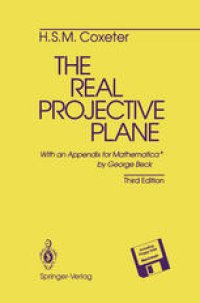
Ebook: The Real Projective Plane: With an Appendix for Mathematica® by George Beck Macintosh Version
- Tags: Geometry
- Year: 1993
- Publisher: Springer-Verlag New York
- Edition: 3
- Language: English
- pdf
Along with many small improvements, this revised edition contains van Yzeren's new proof of Pascal's theorem (§1.7) and, in Chapter 2, an improved treatment of order and sense. The Sylvester-Gallai theorem, instead of being introduced as a curiosity, is now used as an essential step in the theory of harmonic separation (§3.34). This makes the logi cal development self-contained: the footnotes involving the References (pp. 214-216) are for comparison with earlier treatments, and to give credit where it is due, not to fill gaps in the argument. H.S.M.C. November 1992 v Preface to the Second Edition Why should one study the real plane? To this question, put by those who advocate the complex plane, or geometry over a general field, I would reply that the real plane is an easy first step. Most of the prop erties are closely analogous, and the real field has the advantage of intuitive accessibility. Moreover, real geometry is exactly what is needed for the projective approach to non· Euclidean geometry. Instead of introducing the affine and Euclidean metrics as in Chapters 8 and 9, we could just as well take the locus of 'points at infinity' to be a conic, or replace the absolute involution by an absolute polarity.
This introduction to projective geometry can be understood by anyone familiar with high-school geometry and algebra. The restriction to real geometry of two dimensions allows every theorem to be illustrated by a diagram. The subject is, in a sense, even simpler than Euclid, whose constructions involved a ruler and compass: here we have constructions using rulers alone. A strict axiomatic treatment is followed only to the point of letting the student see how it is done, but then relaxed to avoid becoming tedious. After two introductory chapters, the concept of continuity is introduced by means of an unusual but intuitively acceptable axiom. Subsequent chapters then treat one- and two-dimensional projectivities, conics, affine geometry, and Euclidean geometry. Chapter 10 continues the discussion of continuity at a more sophisticated level, and the remaining chapters introduce coordinates and their uses. An appendix by George Beck describes Mathematica scripts that can generate illustrations for several chapters; they are provided on a diskette included with the book. (Both PC and Macintosh versions are available) Mathematica is a registered trademark.
This introduction to projective geometry can be understood by anyone familiar with high-school geometry and algebra. The restriction to real geometry of two dimensions allows every theorem to be illustrated by a diagram. The subject is, in a sense, even simpler than Euclid, whose constructions involved a ruler and compass: here we have constructions using rulers alone. A strict axiomatic treatment is followed only to the point of letting the student see how it is done, but then relaxed to avoid becoming tedious. After two introductory chapters, the concept of continuity is introduced by means of an unusual but intuitively acceptable axiom. Subsequent chapters then treat one- and two-dimensional projectivities, conics, affine geometry, and Euclidean geometry. Chapter 10 continues the discussion of continuity at a more sophisticated level, and the remaining chapters introduce coordinates and their uses. An appendix by George Beck describes Mathematica scripts that can generate illustrations for several chapters; they are provided on a diskette included with the book. (Both PC and Macintosh versions are available) Mathematica is a registered trademark.
Content:
Front Matter....Pages i-xiv
A Comparison of Various Kinds of Geometry....Pages 1-11
Incidence....Pages 12-24
Order and Continuity....Pages 25-38
One-Dimensional Projectivities....Pages 39-54
Two-Dimensional Projectivities....Pages 55-72
Conics....Pages 73-91
Projectivities on a Conic....Pages 92-104
Affine Geometry....Pages 105-125
Euclidean Geometry....Pages 126-146
Continuity....Pages 147-154
The Introduction of Coordinates....Pages 155-168
The Use of Coordinates....Pages 169-199
Back Matter....Pages 200-227
This introduction to projective geometry can be understood by anyone familiar with high-school geometry and algebra. The restriction to real geometry of two dimensions allows every theorem to be illustrated by a diagram. The subject is, in a sense, even simpler than Euclid, whose constructions involved a ruler and compass: here we have constructions using rulers alone. A strict axiomatic treatment is followed only to the point of letting the student see how it is done, but then relaxed to avoid becoming tedious. After two introductory chapters, the concept of continuity is introduced by means of an unusual but intuitively acceptable axiom. Subsequent chapters then treat one- and two-dimensional projectivities, conics, affine geometry, and Euclidean geometry. Chapter 10 continues the discussion of continuity at a more sophisticated level, and the remaining chapters introduce coordinates and their uses. An appendix by George Beck describes Mathematica scripts that can generate illustrations for several chapters; they are provided on a diskette included with the book. (Both PC and Macintosh versions are available) Mathematica is a registered trademark.
Content:
Front Matter....Pages i-xiv
A Comparison of Various Kinds of Geometry....Pages 1-11
Incidence....Pages 12-24
Order and Continuity....Pages 25-38
One-Dimensional Projectivities....Pages 39-54
Two-Dimensional Projectivities....Pages 55-72
Conics....Pages 73-91
Projectivities on a Conic....Pages 92-104
Affine Geometry....Pages 105-125
Euclidean Geometry....Pages 126-146
Continuity....Pages 147-154
The Introduction of Coordinates....Pages 155-168
The Use of Coordinates....Pages 169-199
Back Matter....Pages 200-227
....